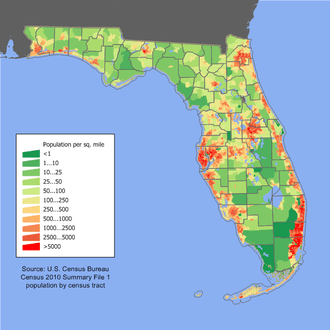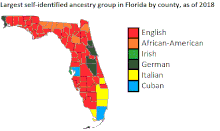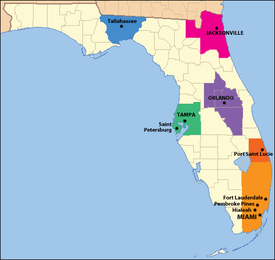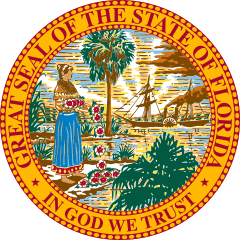Demographics of Florida
Florida is the third-most populous state in the United States. Its residents include people from a wide variety of ethnic, racial, national and religious backgrounds. The state has attracted immigrants, particularly from Latin America.[3] Florida's majority ethnic group are European Americans, with approximately 65% of the population identifying as White. National ethnic communities in the state include Cubans, who migrated en masse following the revolution in mid-century. They have been joined by other immigrants from Latin America, and Spanish is spoken by more than 20% of the state's population, with high usage especially in the Miami-Dade County area.
| Historical population | |||
|---|---|---|---|
| Census | Pop. | %± | |
| 1830 | 34,730 | — | |
| 1840 | 54,477 | 56.9% | |
| 1850 | 87,445 | 60.5% | |
| 1860 | 140,424 | 60.6% | |
| 1870 | 187,748 | 33.7% | |
| 1880 | 269,493 | 43.5% | |
| 1890 | 391,422 | 45.2% | |
| 1900 | 528,542 | 35.0% | |
| 1910 | 752,619 | 42.4% | |
| 1920 | 968,470 | 28.7% | |
| 1930 | 1,468,211 | 51.6% | |
| 1940 | 1,897,414 | 29.2% | |
| 1950 | 2,771,305 | 46.1% | |
| 1960 | 4,951,560 | 78.7% | |
| 1970 | 6,789,443 | 37.1% | |
| 1980 | 9,746,324 | 43.6% | |
| 1990 | 12,937,926 | 32.7% | |
| 2000 | 15,982,378 | 23.5% | |
| 2010 | 18,801,310 | 17.6% | |
| Est. 2019 | 21,477,737 | 14.2% | |
| Sources: 1910–2010[1] 2018 Estimate[2] | |||
Population
With a population of 18.8 million according to the 2010 census, Florida is the most populous state in the Southeastern United States, and the second-most populous state in the South behind Texas. Within the United States, it contains the highest percentage of people over 65 (17.3%), and the 8th fewest people under 18 (21.9%).[4]



Net domestic migration
| Year[5] | In-migrants | Out-migrants | Net migration |
|---|---|---|---|
| 2010 | 482,889 | 427,853 | 55,036 |
| 2011 | 498,597 | 437,202 | 61,395 |
| 2012 | 537,148 | 428,325 | 108,823 |
| 2013 | 529,406 | 423,995 | 105,411 |
| 2014 | 546,501 | 437,516 | 108,985 |
| 2015 | 584,938 | 445,320 | 139,618 |
| 2016 | 605,018 | 433,452 | 171,566 |
| 2017 | 566,476 | 447,586 | 118,890 |
| 2018 | 587,261 | 470,977 | 116,284 |
Race/Ethnicity
2010 census
According to the 2010 census, the racial distributions are as follows; 77.3% White (53.5% Non-Hispanic White), 16.9% African American (includes Afro-Caribbeans), 2.9% Asian American, and 0.5% Native American. 25.6% of the population are Hispanics or Latino (of any race). Florida has one of the largest African-American populations in the country, and has the second-highest Latino population on the East Coast outside of New York state. Its ethnic Asian population has grown rapidly since the late 1990s; the majority are Filipinos, Vietnamese, ethnic Chinese who settled in the Gulf Coast. The state has some federally recognized American Indian tribes, such as the Seminoles in the southeastern part of the state.[6]
2018 American Community Survey
Racial Makeup of Florida (2018)[2]
Racial/Ethnic Makeup of Florida excluding Hispanics from Racial Categories (2018)[2]
NH=Non-Hispanic
Racial Makeup of Hispanics in Florida (2018)[2]
According to the 2018 US Census Bureau estimates, Florida's population was 74.7% White (53.3% Non-Hispanic White), 16.0% Black or African American, 2.8% Asian, 0.3% Native American and Alaskan Native, 0.1% Pacific Islander, 3.3% Some Other Race, and 2.9% from two or more races.[2] The White population continues to remain the largest racial category as Hispanics in Florida primarily identify as White (81.9%) with others identifying as Some Other Race (11.3%), Multiracial (3.4%), Black (2.8%), American Indian and Alaskan Native (0.3%), Asian (0.1%), and Hawaiian and Pacific Islander (0.1%).[2] By ethnicity, 26.1% of the total population is Hispanic-Latino (of any race) and 73.9% is Non-Hispanic (of any race). If treated as a separate category, Hispanics are the largest minority group in group in Florida.[2]
As in other Deep South states settled largely in the 19th century, the vast majority have British Isles ancestry.[7]
Birth data
Note: Prior to 2016, births in the table exceed 100% because some Hispanics were counted both by their ethnicity and by their race, giving a higher overall number. Since 2016, data for births of White Hispanic origin are not collected, but included in one "Hispanic" group; persons of Hispanic origin may be of any race.
| Race | 2013[8] | 2014[9] | 2015[10] | 2016[11] | 2017[12] | 2018[13] |
|---|---|---|---|---|---|---|
| White: | 154,791 (71.8%) | 159,035 (72.3%) | 162,594 (72.5%) | ... | ... | ... |
| > Non-Hispanic White | 98,586 (45.7%) | 100,837 (45.8%) | 102,549 (45.7%) | 99,344 (44.1%) | 96,280 (43.1%) | 95,868 (43.2%) |
| Black | 52,959 (24.6%) | 53,148 (24.1%) | 53,699 (23.9%) | 48,928 (21.7%) | 49,428 (22.1%) | 48,174 (21.7%) |
| Asian | 7,265 (3.4%) | 7,402 (3.4%) | 7,603 (3.4%) | 7,178 (3.2%) | 7,015 (3.1%) | 6,996 (3.2%) |
| American Indian | 392 (0.2%) | 406 (0.2%) | 373 (0.2%) | 237 (0.1%) | 429 (0.2%) | 413 (0.2%) |
| Hispanic (of any race) | 59,206 (27.5%) | 61,849 (28.1%) | 64,078 (28.6%) | 65,895 (29.3%) | 67,049 (30.0%) | 67,201 (30.3%) |
| Total Florida | 215,407 (100%) | 219,991 (100%) | 224,269 (100%) | 225,022 (100%) | 223,630 (100%) | 221,542 (100%) |
Languages
| Language | Percent of population (2010)[14] |
|---|---|
| English | 73.36% |
| Spanish | 19.54% |
| French Creole (including Haitian and Antillean Creoles) | 1.84% |
| French | 0.60% |
| Portuguese | 0.50% |
| German | 0.42% |
| Tagalog, Vietnamese, Italian (tied) | 0.31% |
| Arabic | 0.22% |
| Chinese | 0.20% |
| Russian | 0.18% |
| Polish | 0.14% |
As of 2010, 73.36% of Florida residents age 5 and older spoke English at home as a primary language, while 19.54% spoke Spanish, 1.84% French Creole (mostly Haitian Creole), 0.60% French and 0.50% Portuguese. In total, 26.64% of Florida's population age 5 and older spoke a mother language other than English.[14]
Florida's public education system identified more than 200 first languages other than English spoken in the homes of students.[15] In 1990, the League of United Latin American Citizens (LULAC) settled a class action lawsuit against the state Florida Department of Education with a consent decree that required educators to be trained in teaching English for Speakers of Other Languages (ESOL).[16]
Article II, Section 9, of the Florida Constitution provides that "English is the official language of the State of Florida." This provision was adopted in 1988 by a vote following an Initiative Petition.
A Miami accent has developed among persons born and/or raised in and around Miami-Dade County and a few other parts of South Florida.[17] It is more prominent among Hispanics (especially Cuban Americans and other Latino groups, influenced by the Spanish language).[18][19]
Religion
Florida residents identify as mostly of various Protestant groups. Roman Catholics make up the single largest denomination in the state. Florida residents' current religious affiliations are shown in the table below:[20]
- Christianity 70%
- Protestantism 46%
- Evangelical Protestant 24%
- Mainline Protestant 14%
- Historically Black Protestant 8%
- Catholicism 21%
- Mormonism 1%
- Jehovah's Witness 1%
- Other Christian 1%
- Protestantism 46%
- Non-Christian Faiths 6%
- Judaism 3%
- Other religion 3%
- Unaffiliated 24%
Veterans
There were 1.6 million veterans in Florida in 2010, representing 8% of the total population.[21]
Migration
In 2013, most net migrants come from 1) New York, 2) New Jersey, 3) Pennsylvania, and 4) the Midwestern United States; emigration is higher from these same states. For example, about 50,000 moved to New York; but more than 50,000 persons moved from New York to Florida.[22]
References
- Resident Population Data. "Resident Population Data – 2010 Census". 2010.census.gov. Archived from the original on July 21, 2011. Retrieved November 4, 2011.
- "B03002 HISPANIC OR LATINO ORIGIN BY RACE - Florida - 2018 American Community Survey 1-Year Estimates". U.S. Census Bureau. July 1, 2018. Retrieved November 25, 2019.
- "State Population Facts - Florida". npg.org. Archived from the original on March 30, 2008. Retrieved April 2, 2008.
- Michael B. Sauter; Douglas A. McIntyre (May 10, 2011). "The States With The Oldest And Youngest Residents". wallst.com.
- "State-to-State Migration Flows".
- "U.S. Census Bureau QuickFacts: Florida". Census Bureau QuickFacts. December 21, 2010. Retrieved August 11, 2019.
- Burian, A. Ward (July 3, 2018). The Creation of the American States. Morgan James Publishing. p. 349. ISBN 978-1-68350-910-3.
- https://www.cdc.gov/nchs/data/nvsr/nvsr64/nvsr64_01.pdf
- https://www.cdc.gov/nchs/data/nvsr/nvsr64/nvsr64_12.pdf
- https://www.cdc.gov/nchs/data/nvsr/nvsr66/nvsr66_01.pdf
- https://www.cdc.gov/nchs/data/nvsr/nvsr67/nvsr67_01.pdf
- https://www.cdc.gov/nchs/data/nvsr/nvsr67/nvsr67_08-508.pdf
- "Data" (PDF). www.cdc.gov. Retrieved December 2, 2019.
- "Florida". Modern Language Association. Retrieved August 15, 2013.
- MacDonald, Victoria M. (April 2004). "The Status of English Language Learners in Florida: Trends and Prospects" (PDF). Education Policy Research Unit, Arizona State University. Archived from the original (PDF) on February 9, 2014. Retrieved May 24, 2013.
- "League of United Latin American Citizens (LULAC) et al. vs. State Board of Education et al. Consent Decree". United States District Court for the Southern District of Florida. August 14, 1990. Archived from the original on June 17, 2013. Retrieved May 24, 2013.
- "'Miami Accent' Takes Speakers By Surprise". Articles - Sun-Sentinel.com. June 13, 2004. Retrieved September 2, 2013.
- "Miami Accents: Why Locals Embrace That Heavy "L" Or Not". WLRN-TV and WLRN-FM. Retrieved September 2, 2013.
- "Miami Accents: How 'Miamah' Turned Into A Different Sort Of Twang". WLRN-TV & WLRN-FM. Retrieved September 2, 2013.
- "Adults in Florida". Pew Research Center.
- "What each state's veteran population looks like, in 10 maps". The Washington Post. November 11, 2014. Retrieved August 11, 2019.
- Fishkind, Hank (March 15, 2014). "Harsh winters make Florida attractive for visitors, moves". Florida Today. Melbourne, Florida. pp. 4A. Retrieved March 28, 2014.
